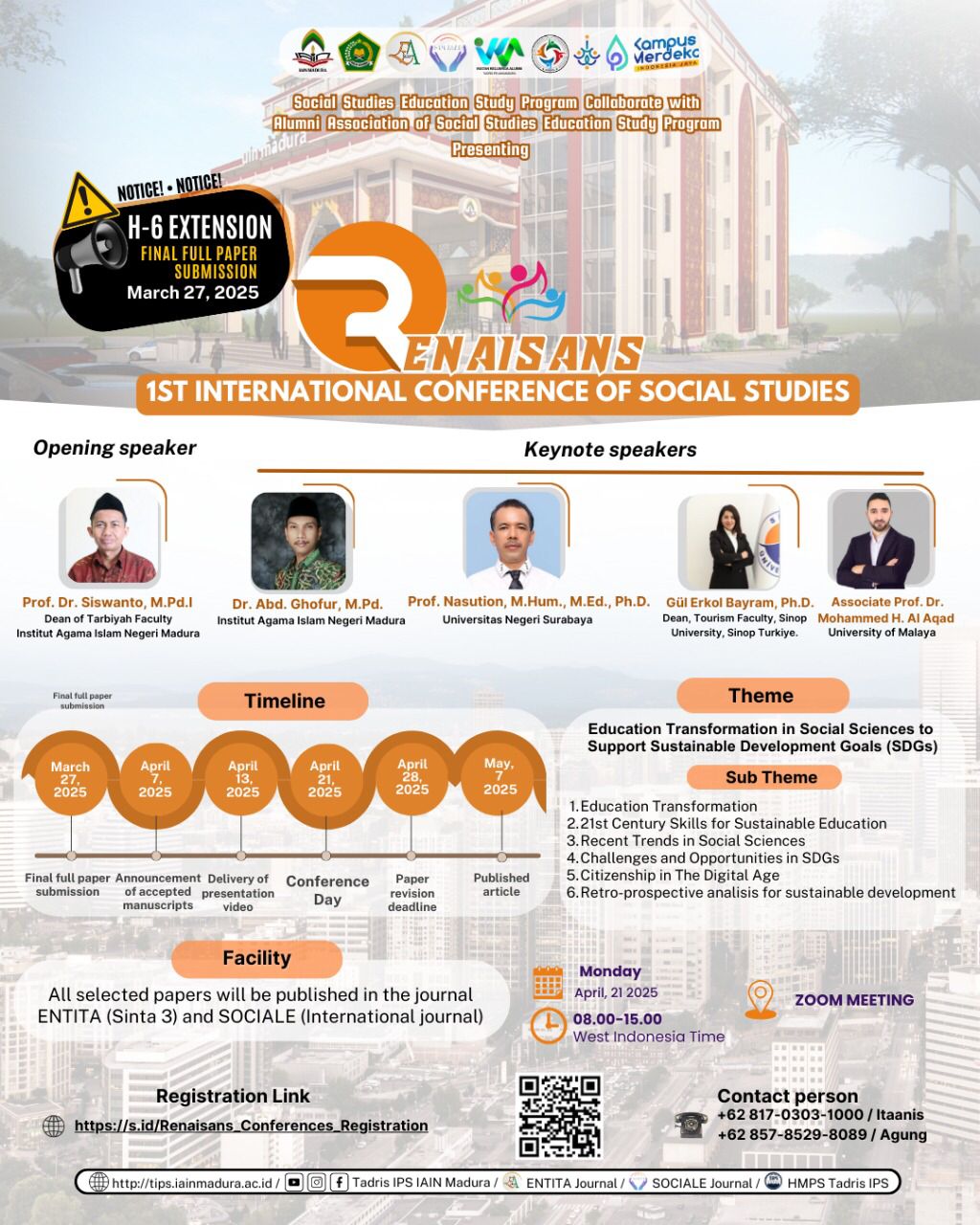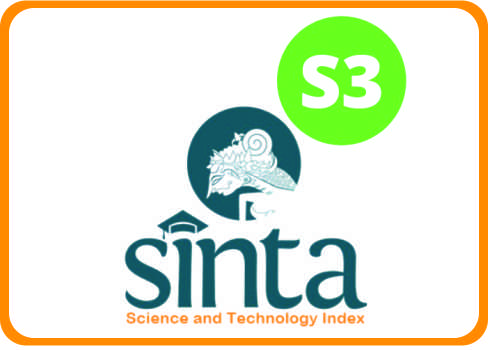Makanan Sebagai Representasi Tradisi Sosial dan Budaya : Kajian Gastrosemiotik Dalam Cerita Rakyat Kuliner
 Abstract views: 3
,
Abstract views: 3
,
 PDF (Bahasa Indonesia) downloads: 1
PDF (Bahasa Indonesia) downloads: 1
Abstract
This study aims to reveal how traditional food not only functions as a story element, but also as a social and cultural marker that contains deep meaning. Food, culture, and identity depicted in literary works reflect the social and cultural dynamics in society. A qualitative descriptive method was used with a focus on literature studies, with data sources from three culinary stories in the Digital Book (BUDI) published by the Ministry of Education and Culture by teachers in Indonesia, namely Nyadran: Learning Tolerance from Tradition, Nasi Berkat, and Tradisi Kupatan. Data collection was carried out through the technique of listening and recording, and data analysis was carried out by data reduction, data presentation, and drawing conclusions/verification. The results of the study show that the three stories have a meaning that is more than just traditional food, but rather a complex representation of the social and cultural traditions of the community. From a gastronomic perspective, this food becomes a "cultural text" that describes the values of solidarity, spirituality, and local wisdom. With Peirce's semiotic approach, this food functions as a sign that strengthens cultural identity, builds social relationships, and awareness of growing social and spiritual. Through ritual ceremonies such as Nyadran, thanksgiving, and kupatan Lebaran, food strengthens relationships between individuals and communities and is a symbol of gratitude and appreciation for others.
Downloads
References
Ahmadi, A. (2011). Cerita Rakyat Pulau Raas dalam Konteks Psikoanalisis Carl G. Jung. Journal Unair, 24(2), 109–116.
Amrullah, Q. L., & Puspitasari, D. (2023). Representation of Cultural Identity of Bangkalan Community through Semiotic Analysis of Halal Culinary Tourism. Acitya: Journal of Teaching and Education, 5(2), 227–243. https://doi.org/10.30650/ajte.v5i2.3595
Asriningsari, A., & Umaya, N. M. (2010). Semiotik: Teori dan Aplikasinya pada Karya Sastra. IKIP PGRI Semarang.
Atkin, A. (2005). Peirce On The Index and Indexical Reference. Transactions of The Charles S. Peirce Society, 41(1).
Atkin, A. (2006). Peirce’s Theory of Signs. Stanford Encyclopedia of Philosophy.
Bandura, A. (2001). Social cognitive theory: An agentic perspective. Annual Review of Psychology, 52(1), 1–26.
Barthes, R. (1957). Mythologies (A. Lavers, Trans.). Hill and Wang.
Counihan, C., & Van Esterik, P. (Eds.). (2013). Food and culture: A reader (3rd ed). Routledge.
Creswell, J. W. (2014). Research design: Qualitative, quantitative, and mixed methods approaches. Sage Publications.
Endraswara, S. (2018). Etodologi penelitian gastronomi sastra. Textium.
Geertz, C. (2013). Agama Jawa: Abangan, Santri, Priyayi dalam Kebudayaan Jawa. Penerbit Komunitas Bambu.
Ginani, V. C., Ginani, J. S., Botelho, R. B. A., Zandonadi, R. P., Akutsu, R. D. C., & Araújo, W. M. C. (2010). Reducing Fat Content of Brazilian Traditional Preparations Does Not Alter Food Acceptance: Development of a Model for Fat Reduction That Conciliates Health and Culture. Journal of Culinary Science & Technology, 8(4), 229–241. https://doi.org/10.1080/15428052.2011.535758
Gladwin, D. (2019). Gastro-modernism: Food, literature, culture (First edition). Clemson university press.
Hefner, R. W. (2000). Civil Islam: Muslims and democratization in Indonesia. Princeton University Press.
Kementerian Pendidikan dan Kebudayaan. (n.d.). Buku Digital, Gerakan Literasi Nasional. https://budi.kemdikbud.go.id/
Kobandaha, R. A., Palar, W. R., & Pangemanan, N. Y. (2023). NILAI ETIKA DALAM CERITA RAKYAT BOLAANG MONGONDOW SEBAGAI UNSUR PEMBENTUK KARAKTER SISWA. KOMPETENSI, 3(02), 1990–2000. https://doi.org/10.53682/kompetensi.v3i02.5883
Koentjaraningrat. (1985). Pengantar ilmu antropologi. Rineka Cipta.
Langer, S. K. (2021). Philosophical Sketches: A Study of The Human Mind in Relation to Feeling, Explored Through Art, Languange, and Symbol. The Johns Hopkins Press.
Lévi, S., C. (1969). The Raw and the Cooked: Introduction to a Science of Mythology (J. Weightman & D. Weightman, Trans). Harper & Row.
Manshur, A., Ma’, M. S., & Syafaat, U. K. M. (2024). Moderasi Beragama dalam Bingkai Sastra: Eksplorasi Pada Lirik Lagu Karya Rhoma Irama. 3(1).
Mawardi, M. F., & Mulyana, A. (2024). GOTONG ROYONG SEBAGAI FONDASI MORAL BUDAYA: PERSPEKTIF HUKUM DAN KEHARMONISAN SOSIAL. Mimbar Justitia, 1(1).
Mead, G. H. (1994). Mind, self, and society: From the standpoint of a social behaviorist. University of Chicago Press.
Miles, M. B., & Huberman, A. M. (2018). Analisis Data Kualitatif. Penerbit Universitas Indonesia (UI -Press).
Mintz, S. W., & Du Bois, C. M. (2002). The Anthropology of Food and Eating. Annual Review of Anthropology, 31(1), 99–119. https://doi.org/10.1146/annurev.anthro.32.032702.131011
Peirce, C. S. (1986). Peirce on signs: Writings on semiotic (J. Hoopes, Ed.). University of North Carolina Press.
Peirce, C. S. (1991). Peirce on signs: Writings on semiotic. NC: University of North Carolina Press.
Pranoto, D. S. (2024). Menyelami Makna dan Filosofis Budaya Tumpeng sebagai Simbol Identitas Kearifan Lokal Bagi Masyarakat. Advances In Social Humanities Research, 2(3), 415–426. https://doi.org/10.46799/adv.v2i3.209
Priyadarshini, S., Bindu, M. R., Sumathy, M., & Dorathy, A. A. (2024). Gastronomic Identities: The Role of Food in Cultural Belonging. Journal of Ecohumanism, 3(7), 3809–3815. https://doi.org/10.62754/joe.v3i7.4502
Putra, A. N. (2021). LITERATURE REVIEW OF FOOD TOURISM, CULINARY TOURISM AND GASTRONOMY TOURISM.
Putra, F. K. K., Putra, M. K., & Novianti, S. (2023). Taste of asean: Traditional food images from Southeast Asian countries. Journal of Ethnic Foods, 10(1), 20. https://doi.org/10.1186/s42779-023-00189-0
Recuero-Virto, N., & Valilla Arróspide, C. (2024). Culinary destination enchantment: The strategic interplay of local gastronomy in regional tourism development. International Journal of Gastronomy and Food Science, 36, 100931. https://doi.org/10.1016/j.ijgfs.2024.100931
Savan, D. (1988). N Introduction to C.S. Peirce’s Full System of Semeiotic. Toronto Semiotic Circle.
Sijabat, A. T., & Harahap, A. B. (2024). Semiotic Analysis of Traditional Food from Simalungun. Asian Journal of Applied Education (AJAE), 3(3), 225–242. https://doi.org/10.55927/ajae.v3i3.9704
Sumanto, A. Q., & Izak, Y. M. L. (2019). Tradisi dan Kebudayaan Nusantara. Nusantara Institutes.
Suseno, F. M. (1984). Etika Jawa: Sebuah Analisa Filsafati tentang Kebijaksanaan Hidup Orang Jawa. PT. Gramedia.
Suyasa, I. M., & Darmurtika, L. A. (2023). Metamorfosis Gastronomi Dalam Karya Sastra Kuliner.
Tobin, R. W. (Director). (2008). Thought for Food: Literature and Gastronomy. [Video recording]. www.uctv.tv/schedule.
Wachidah, L. R., Suwignyo, H., & Widiati, N. (2017). Potensi Karakter Tokoh dalam Cerita Rakyat sebagai Bahan Bacaan Literasi Moral. Jurnal Pendidikan: Teori, Penelitian, Dan Pengembangan, 2(7).
Weber, M. (1978). Economy and Society: An Outline of Interpretive Sociology.
Yani, A. (2021). Kuliner sebagai simbol komunikasi [Disertasi]. Universitas Bina Darma.
Copyright (c) 2025 Entita: Jurnal Pendidikan Ilmu Pengetahuan Sosial dan Ilmu-Ilmu Sosial

This work is licensed under a Creative Commons Attribution-NonCommercial 4.0 International License.
ENTITA: Jurnal Pendidikan Ilmu Pengetahuan Sosial dan Ilmu-Ilmu Sosial operates an Open Access policy under a Creative Commons Non-Commercial 4.0 International license. Authors who publish with this journal agree to the following terms:
- The copyright of the received article once accepted for publication shall be assigned to the journal as the publisher with licensed under a

- Journal is able to enter into separate, additional contractual arrangements for the non-exclusive distribution of the journal's published version of the work (e.g., post it to an institutional repository or publish it in a book), with an acknowledgement of its initial publication in this journal.
- Journal is permitted and encouraged to post their work online (e.g., in institutional repositories or on their website) prior to and during the submission process, as it can lead to productive exchanges, as well as earlier and greater citation of published work (see The Effect of Open Access).
- Here is Copyright Transfer Form that author can download and send to OJS during submission.

















